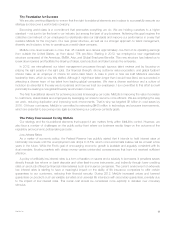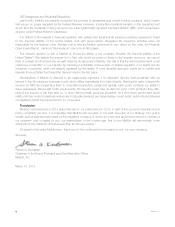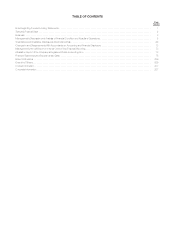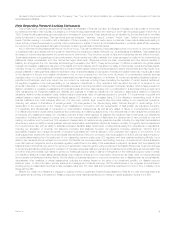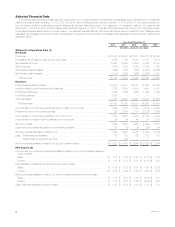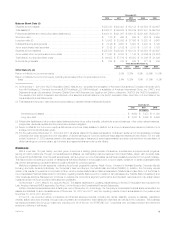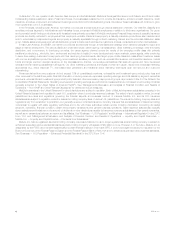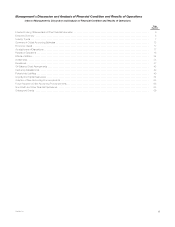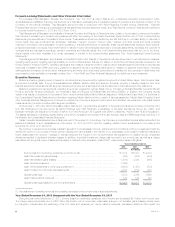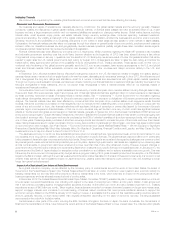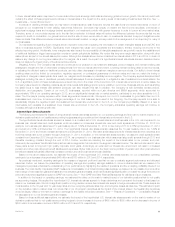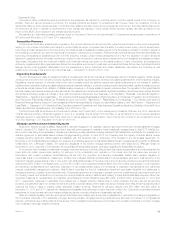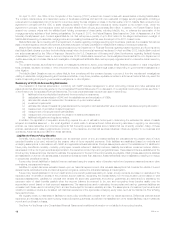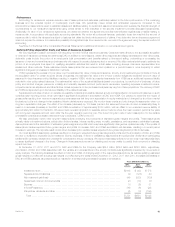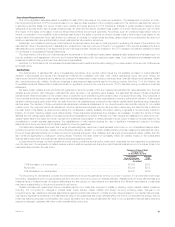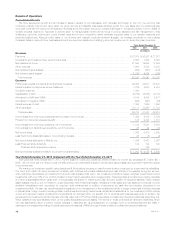MetLife 2012 Annual Report Download - page 14
Download and view the complete annual report
Please find page 14 of the 2012 MetLife annual report below. You can navigate through the pages in the report by either clicking on the pages listed below, or by using the keyword search tool below to find specific information within the annual report.Industry Trends
We continue to be impacted by the unstable global financial and economic environment that has been affecting the industry.
Financial and Economic Environment
Our business and results of operations are materially affected by conditions in the global capital markets and the economy generally. Stressed
conditions, volatility and disruptions in global capital markets, particular markets, or financial asset classes can have an adverse effect on us, in part
because we have a large investment portfolio and our insurance liabilities are sensitive to changing market factors. Global market factors, including
interest rates, credit spreads, equity prices, real estate markets, foreign currency exchange rates, consumer spending, business investment,
government spending, the volatility and strength of the capital markets, deflation and inflation, all affect the business and economic environment and,
ultimately, the amount and profitability of our business. Disruptions in one market or asset class can also spread to other markets or asset classes.
Upheavals in the financial markets can also affect our business through their effects on general levels of economic activity, employment and customer
behavior. While our diversified business mix and geographically diverse business operations partially mitigate these risks, correlation across regions,
countries and global market factors may reduce the benefits of diversification.
Financial markets have also been affected by concerns over U.S. fiscal policy. While uncertainty regarding the “fiscal cliff” (a series of tax increases
and automatic government spending cuts that would have become effective at the beginning of 2013) has been abated following a last minute
Congressional compromise on January 1, questions over the direction of U.S. fiscal policy remain as a result of further Congressional action that willbe
needed to again raise the U.S. federal government’s debt ceiling by August 2013. Unless steps are taken to raise the debt ceiling and reduce the
federal deficit, rating agencies have warned of the possibility of future downgrades of U.S. Treasury securities. These issues could, on their own, or
combined with the slowing of the global economy generally, send the U.S. into a new recession, have severe repercussions to the U.S. and global
credit and financial markets, further exacerbate concerns over sovereign debt of other countries and disrupt economic activity in the U.S. and
elsewhere.
In September 2012, Moody’s Investors Service (“Moody’s”) changed its outlook for the U.S. life insurance industry to negative from stable, saying it
expects interest rates to remain in the low single digits for the next few years, depressing such companies’ earnings. In June 2012, Moody’s announced
that it downgraded the long-term ratings and standalone credit for a number of banks and securities firms with global capital markets operations.
Through our ongoing credit evaluation process, we have been closely monitoring our financial institution investment holdings, including the impact of the
Moody’s downgrades to these institutions, and do not expect these downgrades to have a material adverse effect on our business, results of
operations and financial condition.
Concerns about economic conditions, capital markets and the solvency of certain European Union member states, including Portugal, Ireland, Italy,
Greece and Spain (“Europe’s perimeter region”) and Cyprus, and of financial institutions that have significant direct or indirect exposure to debt issued
by these countries, have been a cause of elevated levels of market volatility. See “— Investments — Current Environment” for information regarding
credit ratings downgrades, support programs for Europe’s perimeter region and our exposure to obligations of European governments and private
obligors. The financial markets have also been affected by concerns that other European Union member states could experience similar financial
troubles, that some countries could default on their obligations, have to restructure their outstanding debt, or be unable or unwilling to comply with the
terms of any aid provided to them, that financial institutions with significant holdings of sovereign or private debt issued by borrowers in Europe’s
perimeter region could experience financial stress, or that one or more countries may exit the Euro zone, any of which could have significant adverse
effects on the European and global economies and on financial markets, generally. In September 2012, the European Central Bank (“ECB”) announced
a new bond buying program, Outright Monetary Transactions, intended to stabilize the European financial crisis and help certain countries struggling with
their levels of sovereign debt. This program involves the purchase by the ECB of unlimited quantities of short-term sovereign bonds, with maturities of
one to three years. These large scale purchases of short-term sovereign bonds are intended to increase the price of the bonds, and lower their interest
rates, making it less expensive for certain countries to borrow money. As a condition to participating in this program, countries must agree to strict levels
of economic reform and oversight. See “Risk Factors — Economic Environment and Capital Markets-Related Risks — We Are Exposed to Significant
Financial and Capital Markets Risk Which May Adversely Affect Our Results of Operations, Financial Condition and Liquidity, and May Cause Our Net
Investment Income to Vary from Period to Period” in the 2012 Form 10-K.
The Japanese economy, to which we face substantial exposure given our operations there, has experienced weak economic performance for over
two decades and a long period of deflation, which have led to a deterioration in public finances. The global financial crisis and March 2011 earthquake
further pressured Japan’s budget outcomes and public debt levels. Going forward, Japan’s structural and demographic challenges may continue to limit
its potential growth unless reforms that boost productivity are put into place. Japan’s high public sector debt levels are mitigated by low refinancing risks
and its nominal yields on government debt have remained at a lower level than that of any other advanced country. However, frequent changes in
government have prevented policy makers from implementing fiscal reform measures to put public finances on a sustainable path. In January 2013, the
government and the Bank of Japan pledged to strengthen policy coordination to end deflation and to achieve sustainable economic growth. This was
followed by the announcement of a supplementary budget stimulus program totaling 2% of gross domestic product and the adoption of a 2% inflation
target by the Bank of Japan. Although the yen has weakened and the stock market has rallied on the back of these announcements, it is too soon to tell
whether these actions will have a sustained impact on Japan’s economy. Japan’s public debt trajectory could continue to rise until a strategy to boost
longer term growth is implemented.
Impact of a Sustained Low Interest Rate Environment
As a global insurance company, we are affected by the monetary policy of central banks around the world. In the United States, the Board of
Governors of the Federal Reserve System (the “Federal Reserve Board”) has taken a number of actions in recent years to spur economic activity by
keeping interest rates low and may take further actions to influence interest rates in the future, which may have an impact on the pricing levels of risk-
bearing investments, and may adversely impact the level of product sales.
In December 2012, the Federal Reserve Board’s Federal Open Market Committee (“FOMC”) reiterated its plan to keep interest rates low until such
time as certain numerical thresholds are met, including with respect to the rates of unemployment, inflation and long-term inflation. It also announced
that it will continue purchasing agency mortgage-backed securities at a pace of $40 billion per month and will purchase longer-term U.S. Treasury
securities at a pace of $45 billion per month. Taken together, these actions are intended to maintain downward pressure on longer-term interest rates,
support mortgage markets, and contribute to a broad easing of financial market conditions that could provide additional stimulus to support the
economic recovery. Based on the FOMC’s January 2013 meeting, however, it is possible that the extent of this quantitative easing could be varied in
amount, gradually reduced, or even ended earlier than originally anticipated depending on the pace of economic recovery, including substantial
improvement in the outlook for the labor market.
Central banks in other parts of the world, including the ECB, the Bank of England, the Bank of Japan, the Bank of Australia, the Central Bank of
Brazil and the Central Bank of China, have followed the recent actions of the Federal Reserve Board to lower interest rates. The collective effort globally
8MetLife, Inc.


